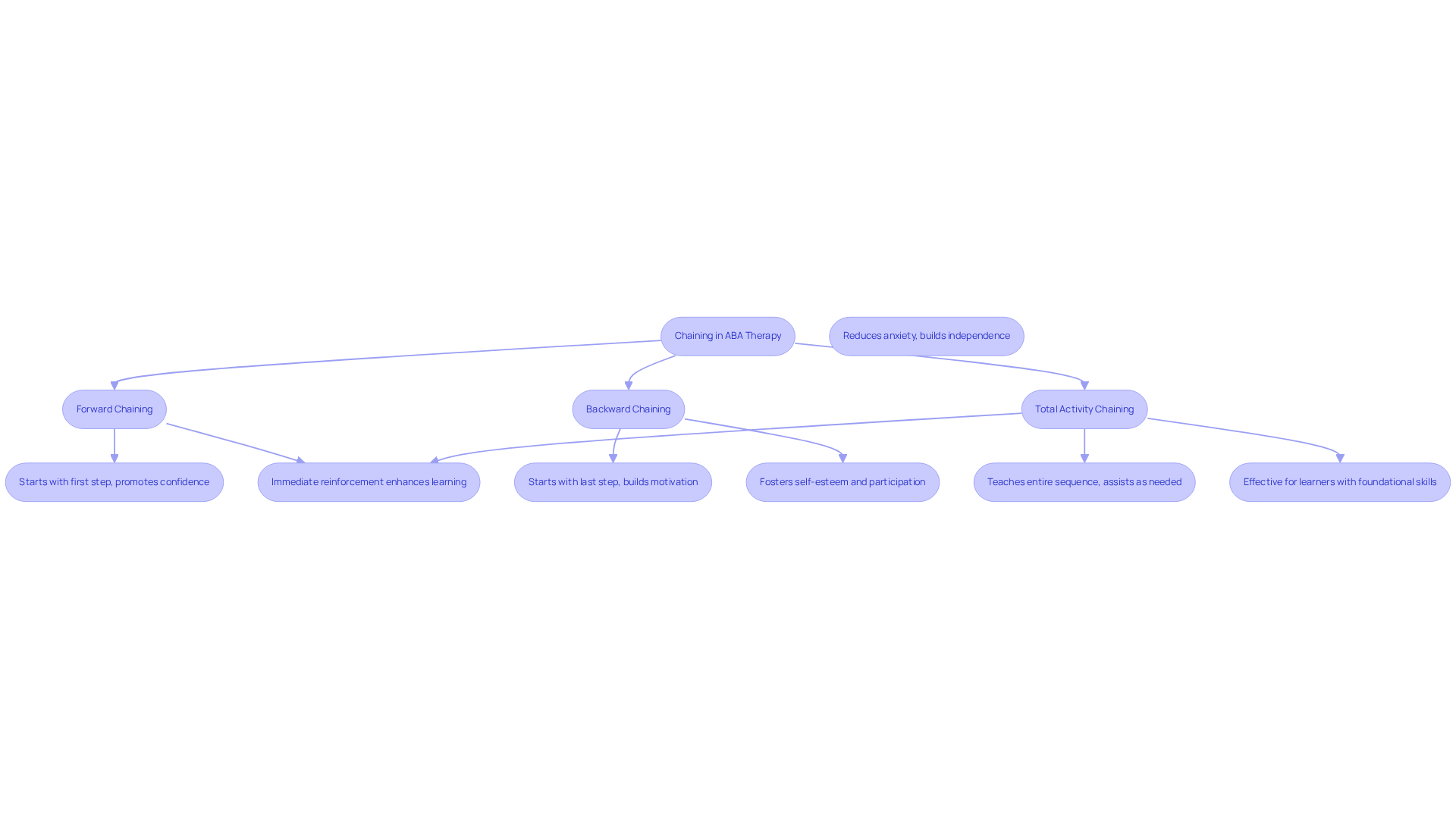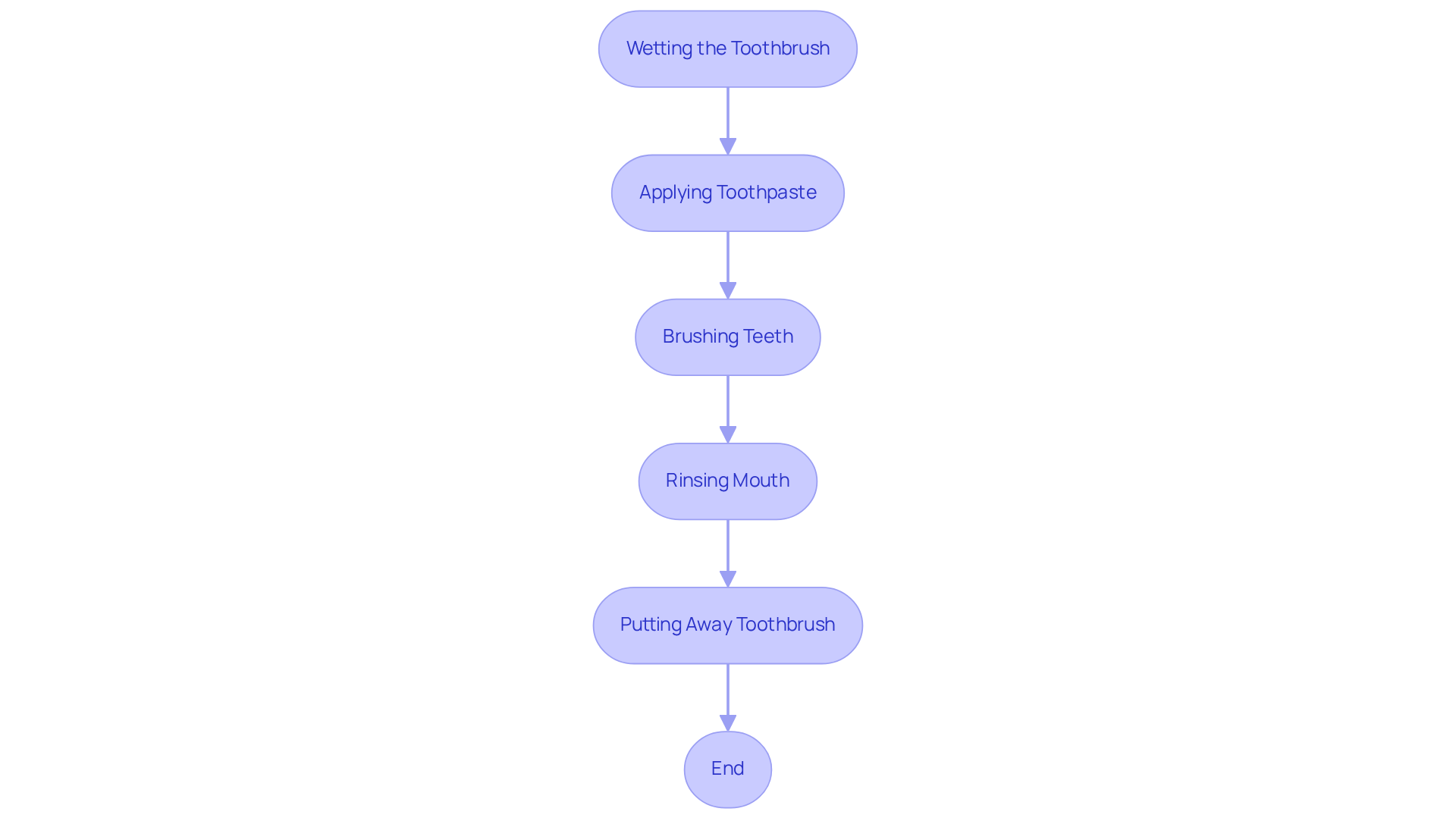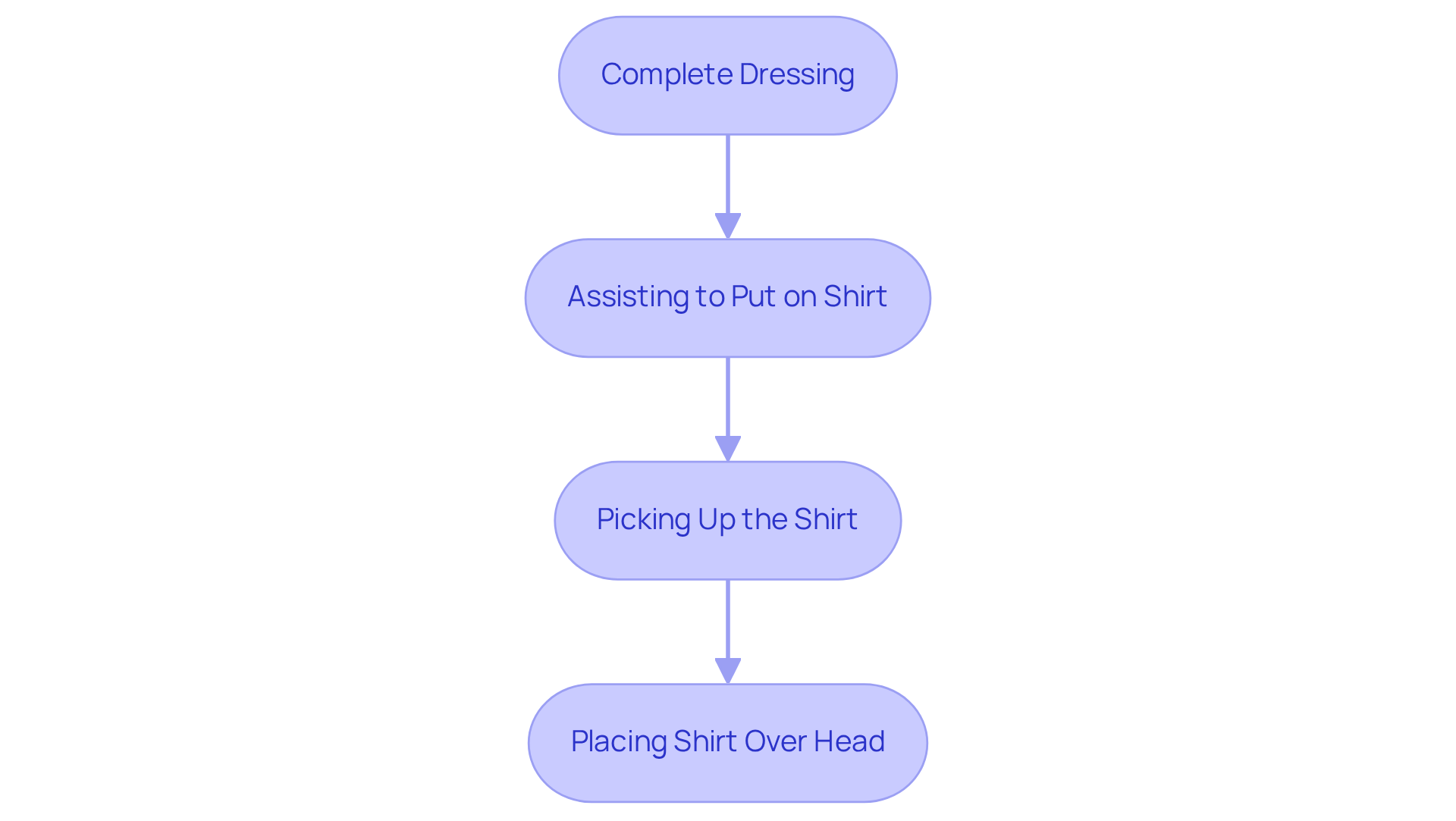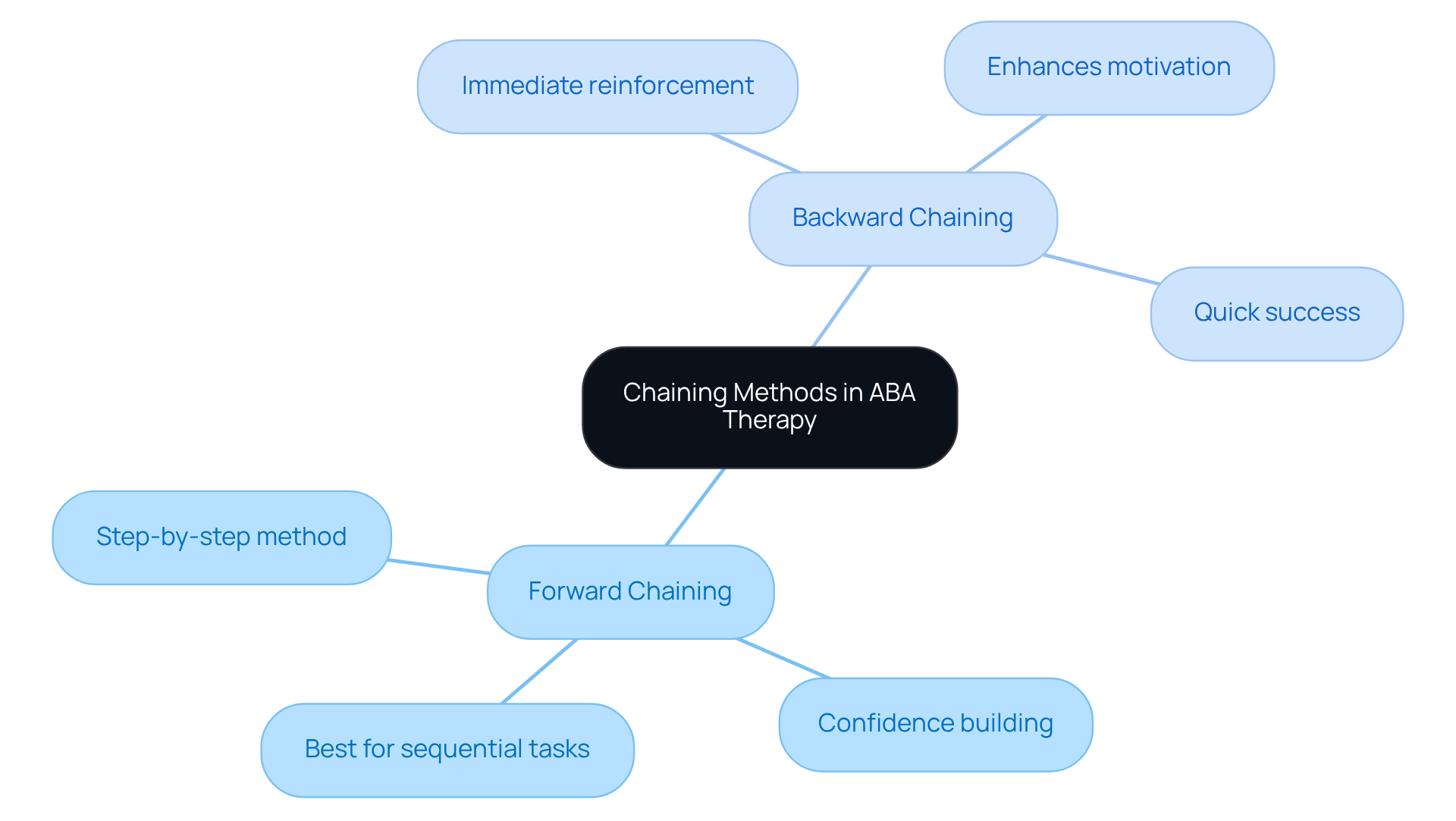September 25, 2025

The demand for Board Certified Behavior Analysts (BCBAs) is on the rise, underscoring the importance of effective teaching methodologies in Applied Behavior Analysis (ABA) therapy. This article delves into the distinct methodologies of forward chaining and backward chaining, both pivotal in teaching complex skills.
As you reflect on your current hiring challenges, consider how these methodologies can be integrated into your practice to enhance learning outcomes. The effectiveness of ABA hinges on the strategic application of these approaches, making it crucial to understand their implications. Ultimately, the choice between forward and backward chaining should be informed by the learner's context and goals, ensuring that each individual receives the tailored support necessary for success.
Chaining techniques are pivotal in Applied Behavior Analysis (ABA) therapy, functioning as essential strategies for teaching complex behaviors by deconstructing them into manageable steps. Among these techniques, forward chaining and backward chaining emerge as prominent methods, each presenting distinct advantages tailored to various learning styles. Yet, a pressing question arises: which method proves more effective in fostering skill acquisition and independence in individuals with autism? This article examines the fundamental differences between forward and backward chaining, investigating their methodologies, effectiveness, and the specific contexts where each approach excels.
Chaining in Applied Behavior Analysis (ABA) therapy is a pivotal technique for teaching complex behaviors by deconstructing them into smaller, manageable steps. This method links individual actions into a cohesive sequence, allowing participants to master each component before moving on to the next. The three main categories of linking—forward chaining vs backward chaining and total activity linking—each offer distinct methods tailored to individual learning needs.
The concept of forward chaining vs backward chaining suggests that forward progression starts the learning process with the initial phase of a task, enabling the individual to accomplish it autonomously before advancing to later stages. This approach is especially beneficial when the student can effectively interact with the preliminary phases, promoting confidence and alleviating anxiety throughout the educational experience. Research indicates that children using forward sequences required fewer prompts over time, significantly enhancing their handwashing skills.
Conversely, in the context of forward chaining vs backward chaining, backward progression begins with the final phase of an activity, guiding the individual through all prior actions until they can autonomously accomplish the last move. This method is advantageous for fostering a sense of accomplishment, as individuals experience instant success with the final phase, which can enhance their motivation and self-worth.
Total activity chaining involves instructing the complete sequence of an activity simultaneously, offering assistance solely for the particular phases the learner finds challenging. This method is particularly effective for individuals who possess the foundational skills necessary for the task but may need assistance with certain components. Prompt reinforcement, such as praise or minor rewards, is essential in this technique, as it strengthens each achieved milestone and promotes ongoing involvement. Reinforcement is crucial in linking behaviors, as it improves learning by making each part of the behavior sequence rewarding.
The prevalence of linking techniques in ABA therapy practices underscores their significance in skill acquisition. Activity analysis functions as a crucial phase in the sequencing process within ABA therapy, enabling practitioners to decompose activities into manageable components. Behavior analysts stress that choosing the suitable sequencing method should be tailored to the learner's needs, objectives, and the particular behaviors being taught. By dividing tasks into manageable portions, linking not only improves skill retention but also encourages independence in daily activities, such as dressing or personal hygiene. Parents and educators can collaborate with the therapist to apply the actions, monitor progress, and strengthen learning in everyday tasks such as brushing teeth or getting dressed. As a result, this practice remains a cornerstone of effective ABA therapy, facilitating meaningful progress for individuals with autism.

The concept of forward chaining vs backward chaining illustrates how forward chaining represents a structured instructional strategy, guiding participants through tasks sequentially from the initial action onward. For example, when instructing a child on tooth brushing, the process begins with wetting the toothbrush, followed by applying toothpaste, and continuing through each subsequent step. This approach not only facilitates early successes for learners but also significantly boosts their confidence and motivation.
Research has shown that when comparing forward chaining vs backward chaining, forward chaining is particularly advantageous for activities requiring a logical sequence, thereby enhancing the learner's understanding of the overall process. Notably, studies reveal an average improvement of 5.79 trials in mastery rates when employing forward sequences, underscoring its effectiveness in skill acquisition.
Real-world applications of forward chaining encompass everyday activities such as dressing, preparing a sandwich, and using the restroom, where deconstructing complex skills into manageable steps fosters independence. Moreover, the flexibility of forward progression across diverse skills underscores its teaching versatility.
However, it is crucial to acknowledge that forward progression may not always yield immediate reinforcement, which can pose a challenge for some learners who thrive on prompt feedback. As Rori Behavioral Innovations articulates, 'Forward sequencing promotes incremental learning and builds self-confidence by allowing individuals with autism to experience early successes.'
In summary, this method stands as a foundational element in ABA therapy, driving incremental learning and enhancing self-efficacy.

Backward chaining is an instructional approach that begins with the final phase of a task and progresses to the initial phase. Consider the example of teaching a child to get dressed: the therapist might first assist the child in putting on a shirt, subsequently guiding them through earlier actions, such as picking up the shirt and placing it over their head. This method provides prompt reinforcement as the learner completes the final phase, fostering a sense of achievement.
Research indicates that backward sequencing can significantly enhance skill acquisition rates, particularly for tasks where the final outcome is highly motivating. For instance, a study found that Mark transitioned from completing zero to one steps in baseline to meeting the criterion after five 40-minute teaching sessions, underscoring the effectiveness of this approach.
Furthermore, a comparative study of forward chaining vs backward chaining revealed that, while both methodologies effectively met learning criteria, backward chaining was more efficient in terms of the average time required to achieve mastery. Specifically, the backward linking procedure demonstrated superior effectiveness regarding the average time to criteria. This efficiency proves especially advantageous in practical applications, allowing individuals to swiftly attain independence in essential skills.
However, it is crucial to recognize that backward linking may require more initial support from the therapist, as learners might not engage with the earlier steps as frequently. As Sanjay Kumar aptly stated, "the ultimate goal of education is to teach students to reach their fullest potential for successful and independent functioning in the community."
Overall, backward linking not only streamlines the learning process but also aligns with the overarching goal of fostering independent functioning in individuals with developmental disabilities.

In the comparison of forward chaining vs backward chaining, distinct differences become evident. Forward progression employs a step-by-step method, allowing learners to build confidence as they master each element of an assignment. This method is especially effective for activities that require a clear sequence and logical progression, such as washing hands or making a bed. Conversely, backward linking emphasizes immediate reinforcement by starting with the final step, which can significantly enhance motivation and enable faster success.
Research indicates that both methods yield positive outcomes in teaching complex skills to children with Autism Spectrum Disorder (ASD). For instance, a study carried out at Dream Big Children's Center showed that participants needed no more than 20 attempts to master activities using either linking method.
While both techniques, forward chaining vs backward chaining, are effective, the choice between them often depends on the individual’s preferences and the nature of the task. Forward progression is typically more appropriate for learners who excel in gradual skill development, whereas backward progression may be more advantageous for individuals who react positively to immediate feedback and reinforcement.
As noted by behavior analysts, understanding the unique needs of each child is crucial in determining the most effective chaining method, allowing for tailored interventions that optimize learning outcomes.

The exploration of forward chaining versus backward chaining in ABA therapy underscores the nuanced approaches to teaching complex behaviors. Each method presents distinct advantages tailored to individual learning styles, highlighting the critical importance of selecting the appropriate strategy to optimize skill acquisition and independence.
Forward chaining empowers learners by encouraging them to master each step sequentially, making it particularly effective for tasks requiring logical progression. Conversely, backward chaining promotes immediate success by starting with the final step, significantly boosting motivation and facilitating quicker mastery. Both methods have proven effective in teaching individuals with Autism Spectrum Disorder, emphasizing the necessity of understanding the unique needs of each learner.
Ultimately, the decision between forward and backward chaining should be informed by the individual's preferences and the specific skill being taught. By recognizing the strengths of each method and customizing interventions accordingly, educators and therapists can cultivate a more effective learning environment that fosters independence and self-efficacy. Embracing these strategies not only enhances learning outcomes but also empowers individuals to navigate daily activities with greater confidence and autonomy.
What is chaining in ABA therapy?
Chaining in Applied Behavior Analysis (ABA) therapy is a technique used to teach complex behaviors by breaking them down into smaller, manageable steps, linking individual actions into a cohesive sequence.
What are the main categories of chaining?
The three main categories of chaining are forward chaining, backward chaining, and total activity linking, each offering distinct methods tailored to individual learning needs.
How does forward chaining work?
Forward chaining starts the learning process with the initial phase of a task, allowing the individual to accomplish it autonomously before advancing to later stages. This method promotes confidence and reduces anxiety.
What are the benefits of forward chaining?
Research indicates that children using forward chaining required fewer prompts over time, significantly enhancing their skills, such as handwashing.
How does backward chaining differ from forward chaining?
Backward chaining begins with the final phase of an activity and guides the individual through all prior actions until they can accomplish the last move autonomously, fostering a sense of accomplishment and enhancing motivation.
What is total activity chaining?
Total activity chaining involves teaching the complete sequence of an activity simultaneously while providing assistance only for the phases the learner finds challenging.
When is total activity chaining effective?
It is particularly effective for individuals who have foundational skills for a task but may need support with certain components.
Why is reinforcement important in chaining?
Prompt reinforcement, such as praise or minor rewards, is essential in chaining as it strengthens each achieved milestone and promotes ongoing involvement in the learning process.
How does activity analysis function in ABA therapy?
Activity analysis is a crucial phase in the sequencing process that allows practitioners to decompose activities into manageable components, facilitating effective teaching.
How can parents and educators support chaining in ABA therapy?
Parents and educators can collaborate with therapists to apply chaining techniques, monitor progress, and strengthen learning in everyday tasks, such as brushing teeth or getting dressed.
Our expert recruitment strategies and AI-driven sourcing ensure that you receive top-notch candidates quickly, without compromising on quality. Whether you’re looking for BCBAs, Clinical Directors, or RBTs, we’ve got you covered.